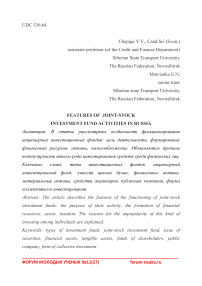Investment fund activities in Russia
Автор: Chepiga Y.V., Matvienko E.N.
Журнал: Форум молодых ученых @forum-nauka
Статья в выпуске: 11-1 (27), 2018 года.
Бесплатный доступ
The article describes the features of the functioning of joint-stock investment funds: the purpose of their activity, the formation of financial resources, assets, taxation. The reasons for the unpopularity of this kind of investing among individuals are explained.
Types of investment funds, joint-stock investment fund, issue of securities, financial assets, tangible assets, funds of shareholders, public company, form of collective investment
Короткий адрес: https://sciup.org/140280275
IDR: 140280275
Текст научной статьи Investment fund activities in Russia
The ongoing financial crises are increasingly causing people to think about where they can invest their own funds in order to preserve and accumulate them. The modern financial market offers various investment options available to the public. Investment funds are one of the possible forms of collective investment of means, the main task of which is to ensure access to the financial market for private investors who have financial resources but do not have special knowledge.
There are two types of investment funds: joint-stock and mutual funds. In accordance with Federal Law No. 156 of November 29, 2001, a joint-stock investment fund is understood as “a joint-stock company whose exclusive subject of activity is investing property in securities” [1].
The activity of joint-stock investment funds has its own characteristics, the main purpose of which is to attract funds from the public through the issuance of securities [2]. The funds received are invested in financial and tangible assets in order to generate income in the form of dividends, interest or increase in the market value of shares. The resulting profit is distributed among investors according to the share of their participation in total investment capital. A joint -stock investment fund has the right to place its shareholders’ financial resources in any form of assets: from shares of leading national corporations to antiques. Fund cash flow management is carried out by licensed professionals.
Formation of financial resources of the joint-stock investment fund is carried out on the basis of the investment declaration adopted at the general meeting of shareholders. The investment declaration contains the basic principles of working with the fund’s capital as well as a list of types of assets and a general scheme for managing the fund.
Assets of a joint-stock investment fund consist of two parts: the authorized capital and the assets necessary for the implementation of administrative activities.
Taxation of fund income depends on the types and terms of investment in securities and other assets. Preferential taxation is also envisaged, provided that some of the shareholders’ funds are sent to charity. The activity of the joint-stock investment fund may be terminated solely by decision of the shareholders meeting.
An important feature of the fund is that, on the one hand, it operates as a public company, and on the other, as an investment fund [3]. The joint-stock investment fund discloses its accountancy in the public information space, and also conducts an open placement of its shares on the stock markets, which allows to judge the transparency of its activities.
In the Russian Federation, funds that concentrate their activity mainly on work in the sectors of real estate, venture capital, innovative production and charity are registered and operate, while their number is very small. In world financial practice, direct investment funds, rental funds, hedge funds, etc. are widely used. There are also hybrid funds that operate using modern methods of operating in financial markets.
This form of collective investment, which appeared in Russia more than 20 years ago, did not become widespread among the population. This can be explained by a number of reasons, in particular, by the general unstable state of the national economy, the lack of the population financial literacy as well as the low liquidity of companies on trading floors.
Currently in Russia, only a small part of the population, approximately about 20 thousands of individuals, have active trading accounts. The share of American households that have invested in corporate securities or government debt instruments does not fall by less than 70% even in times of crisis.
To solve the problem of increasing financial literacy of the population in the Russian Federation at the federal level, a National Strategy for Improving Financial Literacy for 2017–2023 has been developed. In this regard, obtaining knowledge concerning possible ways of investing funds is a necessary component for upbringing a financially literate citizen. The choice of the investment object, quantitative and qualitative assessment of cash inflows and outflows with the account of the existing risks at the micro-, macro- and mesolevels will ultimately determine the effectiveness of investments.
Список литературы Investment fund activities in Russia
- Federal Law of November 29, 2001 No. 156-FZ (as amended on 12/31/2017) "On Investment Funds" (as amended and added, entered into force on February 1, 2017).
- Federal Law of April 22, 1996 No. 39-ФЗ (latest edition) "On the Securities Market".
- Federal Law No. 208-ФЗ dated December 26, 1995 (latest edition ) "On Joint-Stock Companies".


